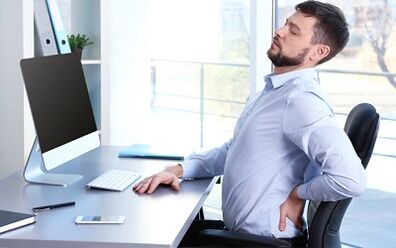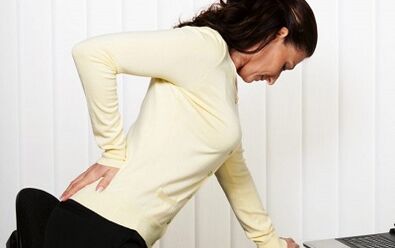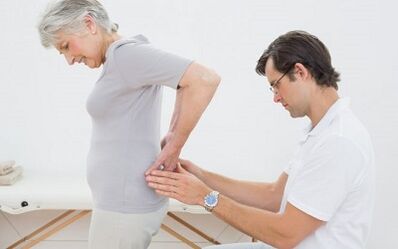
Acute pain in the waist area is a common problem facing the vast majority of people in the context of osteochondrosis of the spine.Getting our straightforward “as a reward” (due to the increased axial load on the spine), the disease will sooner or later affect every inhabitant of the planet, the only question is how quickly this happens, and how the symptoms are expressed.This "lean" statistics force this pathology to a disease of social significance, and the struggle against it should not only be the individual who manifests the disease, but also the task of the entire world health system.Therefore, the treatment of spinal osteochondrosis is a very relevant topic.
So what is osteochondrosis?Briefly consider how the disease develops.In its name, if you translate it from Latin, determine the structure of osteocartilage changes: bone and cartilage.To depreciate and resist vertical loads, a strange fibrous fibrous fibrous "pillow" is placed between our vertebrae - a disc disc.Because blood vessels lost about 25 years of blood vessels, their nutrition was performed in childhood and due to the surrounding muscles, the nutrition began to spread.
The pathological load on the spinal column (sitting work, vice versa), violates the invasion of mineral metabolic processes, the disc loses its elastic and amortized properties, its height decreases, the structure of the vertebrae, structural changes of the vertebrae, pathological skeleton growth (Ostephephytes and Blate plate thephoyphytes and Blotderphytes) is varied.The affected area of the spine.In the late stages of the disease, the central part of the disc, the filamentous jacket nucleus breaks through the annulus of fibrous fibrous, forming a bag of hernias between the vertebrae - the disc hernia.Hernia causes intense pain in the compression of nerve roots adjacent to the vertebrae, and areas where the nerve is affected.Reflex spasms of skeletal muscles occur due to the continuous stimulation of the nerve plexus, known as protective defense in medicine, protects the suffering parts of the spine from excessive movement on the one hand, and enhances compression, edema and pain in the affected area.
In the vast majority of cases (90%) osteochondrosis (even very obvious) pain is caused by muscle cramps!In other cases, the pain is caused by the hernia of the intervertebral disc directly compressing the nerve root or spinal cord.
Osteocartilage of the lumbar spine: How to treat it
Of all parts of the spine, there are five in total (cervix, chest, waist, s bone and tail bone), which is due to the maximum amount of exercise, and the waist is most common in the manifestation of the disease.Osteochondrosis in the lumbar spine has bright symptoms familiar to all, and its treatment is an important social task because it not only deteriorates the quality of life for older people, but also worsens the active working age.
Pain can be directly located in the waist area, the front surface of the thigh, or along the entire back or outer surface of the legs, and sometimes even the fingers.Usually, pain can cause pain to the buttocks, s bones, and trot bones, and sometimes they can only be located in these areas, disguised as genital spheres and intestinal diseases, making it difficult to produce a correct diagnosis.The intensity of pain syndrome can be so high that a person loses the ability to make the most exercise, take compulsive postures and loses the ability to sleep normally.This is the same radiant stone, which in the large circle has long been synonymous with the disease itself.

Restrict sports activities.The usual movement and sensitivity of the limbs are violated, muscle twitching, and sensation abnormalities (stinging, burning "crawling chicken skin") occur.
Violate the function of the pelvic organs.Due to the strong radiation syndrome, everyone is called a radiation stone, or may be subjected to huge hernia protruding, urination and intestinal work, and may even be disturbed, causing severe torture to the patient.
Lumbar treatment for patients and doctors is often a difficult task.Everyone with this disease is asked by questions: "How to treat osteochondrosis in the lower back?", "How to treat osteochondrosis in the waist area?", "If treatment of osteochondrosis in the waist at home, isn't it helpful at home?
The following doctors will help cope with the aggravation of osteochondrosis and prescribe: therapist, neurologist, medical massage specialist, manual therapist, physical therapist, and if necessary, surgical treatment is neurosurgery.
Methods to combat lumbar vertebrae
The main purpose of treating osteochondrosis is the right way of life!Among those who actively, correctly participate in sports culture and monitor the spine, the back will never be hurt!Unfortunately, few people follow these simple facts.
By analyzing this problem, you can highlight:
- drug;
- Non-drug.
Non-drug treatment of lumbar pathology
- Distracting procedures.Their effect lies in the name itself - as the effect on the surface nerve ends and blood vessels slightly reduces muscle spasms and pain syndromes, various applicators, massage carpets and rollers, sheepwool belts, "lotion" and "friction".These methods can be used as auxiliary methods, but the isolated use exacerbates osteochondrosis in the waist area without systemic treatment with special drugs.
- Fixed means.These means are understood as bandages of various designs, with wear allowing you to protect your spine from sudden and "dangerous" movements and redistribute the load during static work.The fixation method can be purchased in the store of medical equipment and pharmacies, however, it is recommended that before purchasing a doctor, consulting a doctor in your case will help determine the optimal design, rigidity and completion of the bandage.It is recommended to use them only for periods of exposure to adverse factors (via the steering wheel, sitting and working, etc.) as prolonged use can lead to muscle atrophy.
- Medical Sports (Exercise Therapy)- An integral part of complex treatment of osteochondrosis.Exercises designed to maintain the muscle tone of the back frame and to remove pathological muscle spasms help restore and maintain motor activity, thereby reducing the intensity of the pain syndrome.An important exercise therapy is that after teacher training, a person can exercise independently at home every day, and use a set of applicable exercises even when the process intensifies.The most effective method of exercise therapy is mechanical therapy – according to the method developed separately for the simulator category, as the formation of muscle corsets requires weight.
- massage- From ancient times, the most common, perhaps the most common prevention and treatment method, but cannot be used in the stages that aggravate lumbar osteochondrosis.In addition, only medical education experts know the skills of anatomy and physiology and medical massage to perform osteochondrosis massage.
- Manual therapyIn recent years, osteotherapy by qualified professionals can produce significant healing effects and even eliminate long-standing aggravation of disease.It is also important to remember that when addressing a manual therapist before the operation begins, it is necessary to perform tool examinations on the spine (radiography, calculation or magnetic resonance imaging, ossification sensitometers) to enable the doctor to evaluate the prevalence and severity of the process and to rule out possible manipulation constructs.Like massage, manual therapy and osteotherapy also have many contraindications, such as significantly compressing the nerve roots of the hernia, subluxation of the vertebrae.During the acute period of osteochondrosis in the lumbar area, soft techniques of manual treatment (muscle relaxation, etc.) are usually used.
- acupuncture.According to recent research results, this methodological use, popular in wide circles, is considered an evidence-based drug, which is unreasonable for lumbar osteochondrosis, which does not eliminate symptoms of the disease and refers to non-traditional treatments.
- physiotherapyIts effectiveness in treating this disease has long been demonstrated among the osteochondrosis medical services provided in national clinical recommendations and standards.Use osteocartilage of the lumbar spine, muscle stimulation, amplifier therapy, shock wave therapy, intra-bone stimulation, laser therapy.Magnetic therapy remains a popular approach in complex treatments.Its advantages include good tolerance and a small number of contraindications, which are the possibility of use during acute periods of the disease.Works on all links to the pathological process, and through multiple processes, it greatly relieves pain and allows a person to expand their motor activities.Additionally, by improving nutrition in affected tissues, it slows down the progress of the disease.The unconditional advantage of this approach is the possibility of independent use by patients outside the walls of the medical institution.
But if all the non-pharmacological methods mentioned above are ineffective - how to treat lumbar osteochondrosis?
Drug treatment
Disease involves the appointment of the following drug groups.
Nonsteroid anti-inflammatory drugs (NSAIDs) are produced in topical form (gels, ointments, creams) and are used for systemic use (a solution for tablets, candles, intramuscular and intravenous administration).Their role is based on blocking the inflammatory process at the enzymatic levels, resulting in elimination of edema in the lesion area and a significant reduction in pain syndrome.
In the early stages of the disease, combined with a non-valley approach (therapeutic exercise, magnetic therapy), there is sufficient topical use of NSAIDS.With obvious pathological processes and strong pain syndromes, you have to resort to tablets and sometimes medications that can be injected.
Unfortunately, NSAID has good anti-inflammatory and analgesic effects, with the development and intensification of gastrointestinal ulcerative osmotic processes as systemic use is prolonged, and kidney and liver function is impaired.Therefore, patients who take NSAID for a long time need conventional laboratory-controlled medications that protect the gastric mucosa and liver and kidneys.
Systemic muscle relaxant, a drug that reduces muscle spasms.Their principle is in the title: Spasmodic muscle relaxation helps reduce nerves and blood vessels compression, edema in the injury area - improved blood circulation and innervation - reduced pain; reduced voltage of ligament devices due to reduced muscle defense - reduced stab wounds (herniation) of intervertebral discs - pain subsides, and increased exercise volume.
Myosin used to treat spinal osteocartilage is produced in the form of tablets and intramuscular solutions for therapeutic effects, and they must be taken for a long time and the dose is gradually increased.Muscle relaxants have many contraindications, just like NSAID, which can cause adverse side effects, so although sold for free in the pharmacy network, you need to consult a doctor before purchasing them.

Local anesthetics or drugs are used for local anesthesia, which is used to treat medication in the form of SO called SO osteocartilage when first subcutaneously administered a drug solution and then enter the so-called venous compression of the vertical vertebrae.
When it accumulates on the membrane of nerve fibers, the drug is effective at blocking pain signals.The therapist certainly cannot perform such a lockdown; in order to perform behavior, it is necessary to contact a neurologist or neurosurgeon.
Similarly, a solution of glucocorticoid (GKS) - hormone drugs with significant anti-inflammatory effects are sometimes used for disc administration.Their local application allows you to achieve maximum results when minimizing the risk of adverse side effects of medications.Such lockdowns are conducted 2 to 3 times a year for classes that should be performed by neurologists or neurosurgeons.
B vitamin "B".In any pharmacy, you can find a variety of medications for this group, including oral and intramuscular forms.They are believed to have neurotrophic and mild anal effects, but, based on evidence, no reliable reasons for spinal osteochondrosis have been obtained.
Physical therapy for lumbar vertebrae
Unfortunately, there are times when comprehensive treatments with modern medications, physical therapy, massage and exercise therapy are ineffective - a person continues to experience pain, limiting physical exercise, and the quality of life suffers a significant impact.This occurs later in the disease, when volumetric methods usually form hernia of multiple intervertebral discs.In this case, surgical treatment was shown.Furthermore, surgical SO is known as “attenuation of hernia” that significant compression of the spinal canal can lead to pain in bladder and intestinal function, bone dynamics disorders, and blockade.In this case, the operation is performed according to an emergency command.The purpose of lumbar osteochondrosis in surgical intervention is to mechanically decompress the spinal canal and nerve roots.
Currently, two long-known volumetric surgical methods are used for surgical treatment of osteochondral toxins, as well as minimally invasive endoscopic interventions proposed using laser and radiofrequency effects, which can perform some laser and radiofrequency effects even in local pain relief.
After examining the main methods of treating lumbar vertebrae, I want to notice again that the patient asked, “How to cure lumbar chondromemaranosis?” It should not only rely on the help of the doctor, but also on one’s own strength to understand the importance of a healthy lifestyle, in which proper dosage and physical activities taken are welcomed and, most importantly, in victory, this is the branch of the disease victory.














































